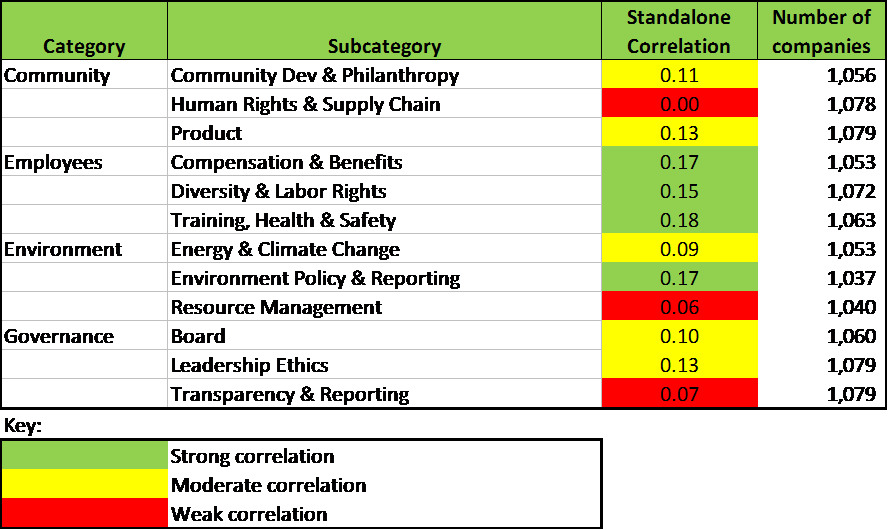By Bahar Gidwani
Part 5 of our 5-part series
In the previous posts in this series, we have described the relationship between Brand Finance’s Brand Strength Index and CSRHub’s sustainability rating. The overall correlation between these large sets of data is strong—and it has been growing stronger. We will now look at how each of the twelve individual components in CSRHub’s metric system relate to brand strength.
CSRHub ingests sustainability information from 230 sources that each have their own way of measuring and rating corporate social performance. In order to make sense of these different measures (we have more than 9,000 different indicators in our system), CSRHub has mapped each indicator from each source into one of twelve “subcategories.” (You can see a description of this schema here.) These subcategories are then grouped into four categories (with three subcategories in each category).
The ratings for each subcategory are forced into a curve that has a central tendency (around 50 on a scale from 0 = low to 100 = high). There is a natural tendency for subcategory scores to be correlated (i.e., a company who is good on one measure of sustainability tends to be better on all of the others), the correlation between subcategories is generally between 0.25 and 0.5 for subcategories that are in the same category (e.g., Energy & Climate Change vs Resource Management) and between 0.1 and 0.25 for subcategories that are in different categories (e.g., Product and Board).
To understand which subcategories may be more important for brand strength, we performed a multivariate analysis between the twelve CSRHub subcategory scores and the Brand Finance Brand Strength Index. The results of the regression mentioned show that eleven of the twelve CSRHub’s subcategories have meaningful individual correlation statistics. Only our Human Rights & Supply Chain measure seems to have no correlation with brand value.
Correlation Between BSI and Each of Twelve CSR Factors
We performed a similar analysis on our 2011 data set—using 921 sets of data. Both the coefficients for the multivariate regression and the relative strengths of the correlations between each subcategory and brand strength were similar. The extent of correlation was less at all levels for the 2011 data.
We would expect that product sustainability, leadership ethics, and a company’s environment policy and reporting would be tied to brand strength. These are areas that companies actively invest in and communicate about. The weaker ties to board performance, transparency and reporting, energy and climate change, and resource management may be due to the fact that consumers have few means to connect these areas with the products they buy. The most surprising results are the weak relationship between brand and human rights and supply chain issues, the modest effect of community development and philanthropy, and that how companies treat their employees is important to their brand strength.
We have some thoughts to offer on these last three points:
- Human rights and supply chain. Our rating in this area goes up when a company is more transparent about its behavior. It also goes up when a company has few “incidents” with its supply chain and when it takes steps to enforce socially positive policies (such as diversity, fair pay, and workplace safety) on its suppliers. We suspect that consumers may not understand the complexity of the issues companies face in this area. They may distrust company communications in this area or dismiss them as “window dressing.” More communication and transparency may indicate that a company has problems in the area, without making it clear that the company has solved some or all of them.
- Community development and philanthropy. Many companies assume their investments in these areas will support their brands. However, it is hard for a company to brag about its good deeds without appearing to be “paying for love.” Further, an investment in one community may not pay off with brand benefits in other/all communities.
- Employee treatment. Many studies have shown that consumer brand impressions are heavily influence by the behavior of a company’s employees. Polite, knowledgeable service people; employees who actively serve in community organizations; and personal contact between employees and customers can directly affect how a brand is perceived.
Conclusion and Next Steps
If corporate social responsibility performance drives brand strength, companies have yet another reason to care about their social performance. We do not advocate cutting expenditures on human rights and supply chain improvements. We believe that consumer awareness in this area will grow rapidly—spurred partly by news coverage of events such as the recent collapse of a factory in Bangladesh. However, we hope that our results show companies that investing in better treatment of their employees may also increase the strength of their brands. Our results also suggest that brand managers may expect to see broad benefits on their brand strength from promoting and leveraging their company’s good social responsibility performance.
We plan to repeat our study using Brand Finance’s next annual BSI data set (due to be released in March 2014). We are also reaching out to other groups who have brand data and digging into the indicators and data we have from our 230 other data sources. We intend to study the performance of “outliers”—companies whose brand and sustainability performance run counter to the general trend we have described. We invite any company or group who is interested in this area to contact us regarding this work. We will need detailed information and input from the management of both brand-driven and non-brand driven companies, if we want to understand best practice in this area.
View:
Part 1 The Tie Between Brand Value and Sustainability is Getting Stronger
Part 2 There is a Strong Link Between Brand Strength and Sustainability
Part 3 Is the Correlation between Brand Strength and Sustainability Due to Random Chance?
Part 4 The Relationship Between Brand and Sustainability is Getting Stronger
 Bahar Gidwani is CEO and Co-founder of CSRHub. He has built and run large technology-based businesses for many years. Bahar holds a CFA, worked on Wall Street with Kidder, Peabody, and with McKinsey & Co. Bahar has consulted to a number of major companies and currently serves on the board of several software and Web companies. He has an MBA from Harvard Business School and an undergraduate degree in physics and astronomy. Bahar is a member of the SASB Advisory Board. He plays bridge, races sailboats, and is based in New York City.
Bahar Gidwani is CEO and Co-founder of CSRHub. He has built and run large technology-based businesses for many years. Bahar holds a CFA, worked on Wall Street with Kidder, Peabody, and with McKinsey & Co. Bahar has consulted to a number of major companies and currently serves on the board of several software and Web companies. He has an MBA from Harvard Business School and an undergraduate degree in physics and astronomy. Bahar is a member of the SASB Advisory Board. He plays bridge, races sailboats, and is based in New York City.
CSRHub provides access to corporate social responsibility and sustainability ratings and information on 7,300+ companies from 135 industries in 93 countries. By aggregating and normalizing the information from 230 data sources, CSRHub has created a broad, consistent rating system and a searchable database that links millions of rating elements back to their source. Managers, researchers and activists use CSRHub to benchmark company performance, learn how stakeholders evaluate company CSR practices and seek ways to change the world.



.png)
